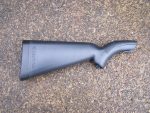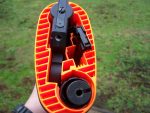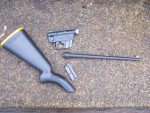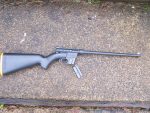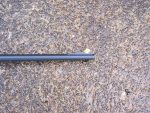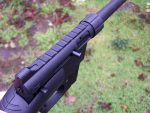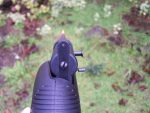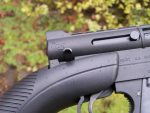When asked by my wife or daughters what I want for my birthday or Christmas, I have a pretty set answer– “something that goes bang or cuts.” So, I’m fairly easy to shop for these days. Last Christmas my beautiful wife bought me a Henry U.S. Survival AR-7 Survival Rifle, and it is a most welcomed addition to my meager firearms battery. While just about any firearm can be used for “survival” purposes, the AR-7 was designed specifically to be a compact rifle that was designed to aid in actual survival situations.
Some history on the AR-7 is in order, of course. The AR-7 was designed by Eugene Stoner, who designed the AR-15/M-16 military rifle that is still in use today, albeit under a different nomenclature. Stoner designed the AR-7 way back in 1958, and it was first mass produced in 1959. The AR-7 was designed with Air Force pilots in mind, first and foremost; in the event they were shot down they would have a weapon for self defense or for hunting food. Now, you simply don’t see the AR-7 in the hands of pilots who were shot down. Instead, they are always seen with a handgun of some kind in a shoulder holster. Given my druthers, in a real survival situation, I much prefer a long gun over a handgun any day of the week.
The AR-7 is chambered in .22 LR and has been manufactured over the years by a number of different gun makers, starting with Armalite. Other makers included Charter Arms, Herter’s Outdoor Supply, and some were made in Argentina as well as in Israel. I’ve owned an original Armalite and the Charter Arms versions over the years, and neither worked reliably enough for me to want to bet my life on them. The AR-7 is a semi-automatic blow-back action rifle that holds an 8-rd magazine. Although after-market mags are available that hold more rounds, I haven’t found one that was reliable.
The unique feature of the AR-7 Survival Rifle is the fact that it is a take-down rifle; the receiver and barrel can be separated from the stock and stored in the plastic stock that is advertised as being “water resistant”. It makes for a very neat package that is easy to carry in a backpack or in a pilot’s survival pack. The entire gun only weighs about 3.5 lbs, and when assembled it is 35 inches long. Stowed in the stock, it is only 16.5 inches long, which is very compact for a rifle.
The front sight on the Henry version is bright orange and made out of plastic, and the rear sight is a peep sight. The Henry version has the receiver and barrel Teflon coated to help prevent it from rusting. There is also a milled rail on the receiver, should one wish to top the AR-7 with some kind of scope. However, the scope would have to be removed before storing the receiver in the stock. Two magazines come with the gun. One can be left in the receiver, and the other has a nice spot inside the stock.
The trigger pull was a bit heavy on my sample, and it came in about 7 lbs; however, it was crisp and smooth. The bolt handle consists of a rounded metal “rod” that stores inside the bolt. To chamber a round, you must pull the bolt handle out of the bolt, pull it back, and release it, to chamber a round. You can then push the bolt handle back into the bolt; it’s all very compact and neat. There is also a tang mounted safety on the receiver that is easy to operate.
Take down and assembly of the AR-7 only takes about a minute. To assemble the rifle, you remove the plastic butt off the stock and take the barrel and receiver out. The receiver has a long tang screw that screws into the butt stock, and then you attach the barrel to the receiver. It has a nut that screws the barrel on tightly. That’s it! Just be sure to tighten the barrel nut as tightly as you can. You can’t put the barrel on “wrong” as there is a groove in it, that slides into the receiver.
The AR-7 is a favorite among bush pilots, who might have the misfortune of making an emergency landing in a remote area. I can already hear hard-core types saying that a .22 LR is no match for a big brown bear in Alaska; I concur. However, the odds are in your favor that you won’t be attacked by one of these big bears. As in life, there are always compromises, and the compact AR-7 is one of those compromises. Bush pilots have to constantly be aware of how much weight they are carrying in their small bush planes, and every ounce counts. The AR-7 with a brick of 500 rds of .22 LR ammo doesn’t take up much space or weigh very much.
The Henry version of the AR-7 comes in two different colors– all black (mine) and a woodland camo type pattern. Other than that, they are identical in all respects. BTW, you can store both magazines that come with the rifle, fully loaded, so at the very least you will have 16 rds of .22 LR on-hand, if you don’t have any extra .22 LR stored in a backpack or your pockets. Early versions on the AR-7 didn’t allow for the magazine to be left in the receiver. You had to remove it before putting it inside of the stock.
As already mentioned, I’ve owned several various AR-7 rifles over the years, and not a single one would function 100% of the time, no matter what ammo I used– hi-velocity, standard velocity, solids, or hollow point ammo. I’m happy to report my Henry AR-7 works flawlessly 100% of the time, no matter what type or brand of ammo I have fed it.
Now, as for accuracy, the gun is deadly out to 50-yards, giving me two-inch groups, if I do my part. However, the overly large, bright orange front sight is a detriment to better accuracy beyond that on small game. Out to 100 yards, I could hit some nice sized rocks, but I wouldn’t trust a shot that far out on small game; the front sight would completely cover the small game. I think Henry would do better to reduce the size of the front sight and make it in all-black instead of the bright orange. While the bright orange is easy to pick up, even in very low-light conditions, it just seems more like a distraction to my way of thinking. A much smaller front sight would be more conducive to better accuracy out to 100 yards and beyond.
Now, to be sure, the .22 LR isn’t a man stopper round. However, it will do the job with proper shot placement. Of course, this isn’t any sort of “assault rifle”. It’s not designed for that role, but it will sure make someone wish they were farther down range from you if you unleashed a mag of ammo at them. It sure beats having to fend-off someone with a sharpened stick or throwing rocks at them.
It does take some getting used to in that there isn’t any front stock to hold onto, just a bare barrel. One is better to put their off-hand in front of the magazine for a better hold on the gun. Plus, the stock/receiver are slightly off-set from one another, too, with the stock sticking out a bit more on the left side than the right. But it’s no big deal once you get used to it.
I filled my bath tub with water and placed the AR-7 in it with the receiver and barrel stowed in the stock. The gun didn’t get wet, period! However, it is advertised as being water “resistant” and not water proof. The gun also floated in the bath tub, too.
I’ve read reports of the barrel nut getting loose from the receiver after extensive firing. I didn’t have this problem, probably because I really snugged the barrel nut down tight to start with. I can see there might be accuracy problems and even problems feeding if the barrel nut isn’t tightened down completely.
Charter Arms produced the Explorer II, which was a pistol version of the AR-7, and I don’t think it ever really caught on because it was an overly large “pistol” to start with. Plus, Charter Arms had to use a different method of attaching the barrel to the receiver than the AR-7 rifle did. So folks couldn’t use the barrel from the rifle on the pistol, or the pistol barrel on the rifle. That’s BATF regulations, ya know.
I’ve seen the AR-7 rifle featured in several movies. The James Bond 007 From Russia With Love was probably the most famous use of the gun, when it was used to take down a bad guy escaping from a secret window. However, Ian Flemming, who wrote the James Bond books, wasn’t any sort of firearms expert, and in the movie the AR-7 was referred to as a “point 25” caliber rifle. I’m assuming they meant a .25ACP round, yet I don’t know of any rifles chambered in .25ACP. Then we have the cornball Matt Helm spoof spy movies. He carried a Charter Arms Explorer II pistol with a delayed firing. When the trigger was pulled, there was a “click” instead of a “bang”, so the bad guy firing the gun would stupidly turn it on himself to see what the problem was. Then, in 10 seconds the gun would fire, killing the bad guy. Okay. Whatever!
Henry Repeating Arms lists the AR-7 U.S. Survival Rifle for $299, and it can be found for around $240 or a bit less, when put on sale. My wife got mine at the local small box membership store for $189, and that was a super sale of a deal. My local gun shop currently has one for $199, and I’m tempted to get it so my wife can have it in her emergency box in the back of her SUV to go along with her bug out bag and other gear that we carry in our e-boxes!
Sure, I’d much rather have an AR-15 of some sort to carry in a SHTF emergency. However, it is much easier and more convenient to have the AR-7 in my e-box, locked in my pickup with a brick of 500 rds of .22 LR ammo. The AR-7 takes-up very little space, and I can toss it in my bug out bag, if necessary, or assemble the gun for ready use. And, as mentioned, the .22 LR isn’t a man stopper of a round, nor is it anything but a small game getting round. However, I know of one guy, who was out of work, raising two kids, and lived out in the boonies, who regularly used a .22 LR rifle to take deer with a shot to the head. Yeah, he was poaching, but he still had to feed his family. So, a shot to the head can take down a deer, and it will also take down a human, if need be.
The Henry AR-7 is a genuine “survival” rifle. It was designed from the start as such a weapon and not one that you would want to take out hunting on a daily basis. Other .22 rifles are much more suitable for those tasks. However, when the chips are down, and space and weight are a serious consideration as well as lots of ammo on-hand, the AR-7 will get the job done!
– Senior Product Review Editor, Pat Cascio










